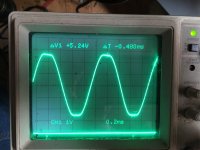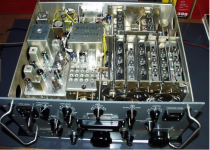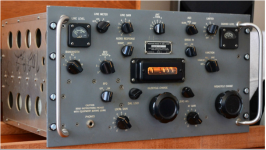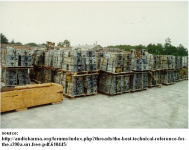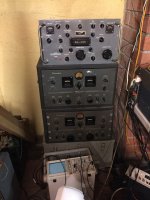Can you imagine the havoc even 2 volts of square wave ripple at RF long to medium wave frequencies would do to radio, TV etc?
I have a great military Collins R390A/URR, and all that I can hear, some local station on medium waves, and few preachers on short waves.
I have a great military Collins R390A/URR, and all that I can hear, some local station on medium waves, and few preachers on short waves.
And the harmonics? As I recall .01 volts of RF delivers a fine television picture.
And the harmonics? As I recall .01 volts of RF delivers a fine television picture.
What harmonics?
All bands are polluted, and almost nobody use them.
What harmonics?
All bands are polluted, and almost nobody use them.
The preachers are fun and get carried away at times realizing there is (probably) no FCC monitoring. The best stuff is not repeatable here for any number of reasons. Though it is a good lesson in who we share this earth with, I'll stick with the punks.
Last edited:
What harmonics?
All bands are polluted, and almost nobody use them.
I do. I also provide lots of wireless microphones. Some folks still listen to the radio AM and FM.
If you ever want to really scare yourself look at the vast areas of the country where AM radio is still dominant and compare that to.... Well that gets political and violates forum rules.
Then there are still business and aviation users.
Just imagine how many services would not exist if the power mains were even 50,000 hertz with distribution at 13,600 volts down to 220/110.
Then we could talk about the health effects from universal diathermy. Or even cooking your food with your metal dental work.
There really are good reasons virtually all regulatory authorities limit EMI.
Last edited:
Thanks everyone for putting up with me. I'll use that old thread and restart it. I still think a separate thread on market directions and consumer preferences would be a lively topic.
Thanks for the kind words John, and it is nice to see you working on something different.
SMPS are the future if not the present so why not use them? As Richard says weight and size advantage goes to smps, Ed shows some superiority in noise transmission and ease of shielding, and they can be external to a device so always upgrade-able to boot and they cost less without all that copper. I really don't understand the resistance except that earlier units may have been problematic.
Thanks for the kind words John, and it is nice to see you working on something different.
SMPS are the future if not the present so why not use them? As Richard says weight and size advantage goes to smps, Ed shows some superiority in noise transmission and ease of shielding, and they can be external to a device so always upgrade-able to boot and they cost less without all that copper. I really don't understand the resistance except that earlier units may have been problematic.
SMPS are the future if not the present so why not use them? As Richard says weight and size advantage goes to smps, Ed shows some superiority in noise transmission and ease of shielding, and they can be external to a device so always upgrade-able to boot and they cost less without all that copper. I really don't understand the resistance except that earlier units may have been problematic.
Why do you think my 42W / Ch SE amp is so small, if each output tube requires 60W for filament?
https://youtu.be/F9gNkHotqpA
Sixty Watts for each filament = 120 Watts of marketing class a.🙂 Nice looking amps with that big tube.
Sixty Watts for each filament = 120 Watts of marketing class a.🙂 Nice looking amps with that big tube.
Marketing?! You did not hear it! 😀
Do you wan a contest, A/B? Double blind? ;-)
42W per channel SE, 20 Hz - 50 KHz without visible roll off on oscillograph. 10:1 probe, soft clipping at 42W
Attachments
However, if you always listen to compressed music and don't care of quiet sounds that create illusion of space, you do not need SE tube amps.
We are using very low active power supply voltages that move with the input signal so that we can use 'high efficiency' super 5V IC op amps as the main driver. We are also using some AD825's for handling part of the signal functions. This is a powerful amp, that you can carry under your arm.
Today we intensely discussed 'arbitrary' details like what board material would be best, what bypass caps, etc.
I don't use IC op amps, in my "high efficiency" Class A amp, for signal handling only as DC servo. Have you looked the link in my post #94669, I would appreciate your opinion?
thanks Damir
Efficiency should be between 70 - 80% in pure Class A
Last edited:
However, if you always listen to compressed music and don't care of quiet sounds that create illusion of space, you do not need SE tube amps.
However, if you often listen to orchestral classical music with extremes fff (forte fortissimo) and ppp (piano pianissimo) and average sensitivity speakers like 89dB/2.83V/m, then? ...... 😉
... you will need >200W, speaking only in power terms, not mentioning modulation of amplitude response by highish SE tube amp output impedance. I agree that SE tubes are a nice toy, but nothing for serious listening 😀
I have a great military Collins R390A/URR,
!!!
and almost nobody use them.
https://www.ntia.doc.gov/files/ntia/publications/2003-allochrt.pdf
George
Attachments
However, if you often listen to orchestral classical music with extremes fff (forte fortissimo) and ppp (piano pianissimo) and average sensitivity speakers like 89dB/2.83V/m, then? ...... 😉
... you will need >200W, speaking only in power terms, not mentioning modulation of amplitude response by highish SE tube amp output impedance. I agree that SE tubes are a nice toy, but nothing for serious listening 😀
...then, you are talking about some mediocre ordinary SE amp, not mine. As I said, it has pretty deep overall feedback through nested loops, but thanks to properly dosed feedbacks in loops it does not clip nasty similarly to all your amps, and it does not cough after that like your amps (that have thermal feedback through massive heatsinks) do. Your 200W is only 6 dB louder than mine, so a bit better speakers would be needed.
Do you want a contest? Welcome. Do you want your imaginably-theoretical musings based on your beliefs? Thank you, I am not interested. I designed enough of solid state amps, that were much better than your copy-pasted opamps designed by others. Why would I do some wrong and stupid things after that like making one more mediocre SE tube amp, what do you think?
Last edited:
Yes, this one. Perfectly tuned. But even it can't catch up so many stations that were available yet 10 years ago... :-(
Attachments
what do you think?
I think you failed to stay within the technical bounds of a discussion and turned your response into a personal attack.

I highlight the words you could have erased and keep your technical argument intact
"...then, you are talking about some mediocre ordinary SE amp, not mine. As I said, it has pretty deep overall feedback through nested loops, but thanks to properly dosed feedbacks in loops it does not clip nasty similarly to all your amps, and it does not cough after that like your amps (that have thermal feedback through massive heatsinks) do. Your 200W is only 6 dB louder than mine, so a bit better speakers would be needed.
Do you want a contest? Welcome. Do you want your imaginably-theoretical musings based on your beliefs? Thank you, I am not interested. I designed enough of solid state amps, that were much better than your copy-pasted opamps designed by others. Why would I do some wrong and stupid things after that like making one more mediocre SE tube amp, what do you think?''
George
Did not you see that I answered on an insult of the person that is well aware of what I was doing before, who knows about my designs, but still in his message he pre-supposed that I made some one more mediocre amplifier for what reason? Tell me please George, for what reason I would build one more mediocre amplifiers that are freely available from China cheap? Do I look like a guy who would sell his soul for money fooling people? Insult in pre-supposition is worse than a direct insult, it is a coward insult.
Last edited:
I've certainly angsted over power. I retired my Radford thinking it wouldn't drive my speakers properly 20 years ago and still need to restore it. I think I made a backwards step at the time. Now I listen in a small room so huge power is not needed, but a few years ago engaged my brain and released that if 40W wont cut it, you really need 400W to go significantly louder. As long as there is enough current going from 40-200W doesn't seem to buy much other than a nice big box. Damn our log hearing.
Then I opened the active speaker can of worms 🙂
Then I opened the active speaker can of worms 🙂
Yes, I over-reacted. And I am sorry for that. But I will stay behind my words that opamp topologies repeated again and again, no matter how refined, can not create such illusion of a space in soundstage how single ended amplifiers do. The only drawback of them is, huge power consumprion. The rest is just technical details, and forte-fortissimo they can reproduce as easy, as PP amps do. You should remember my Tower design, with single ended output, loaded on counter-modulated CCS augmented source follower, driven by vacuum tube driver with enormous speed and linearity. It delivered 200W per channel, consuming more than kilowatt of energy. This amp is different. It is made only of 2 tubes per channel, just assisted by a sand. And I am proud of it, and am ready to contest.
- Status
- Not open for further replies.
- Home
- Member Areas
- The Lounge
- John Curl's Blowtorch preamplifier part II
